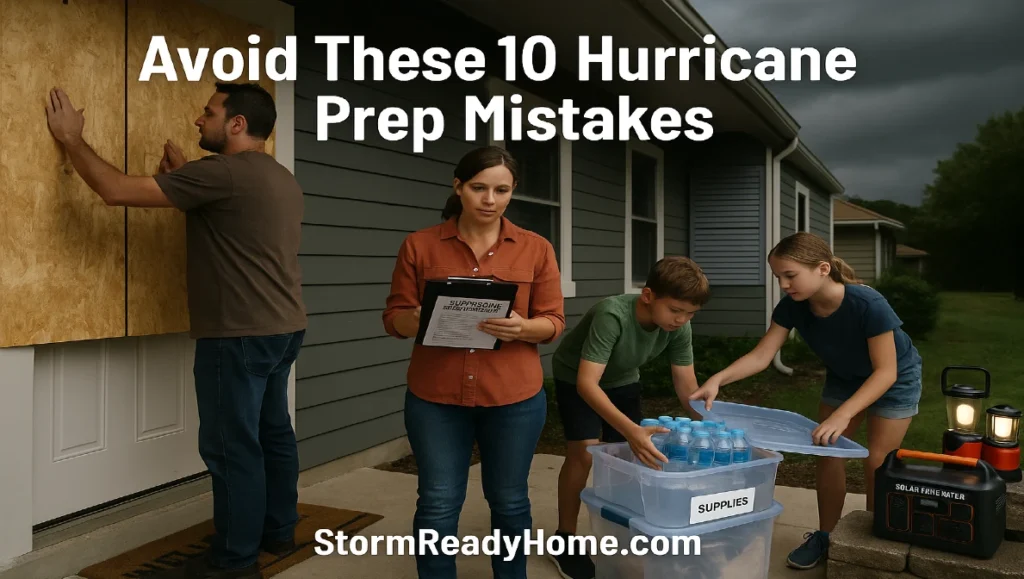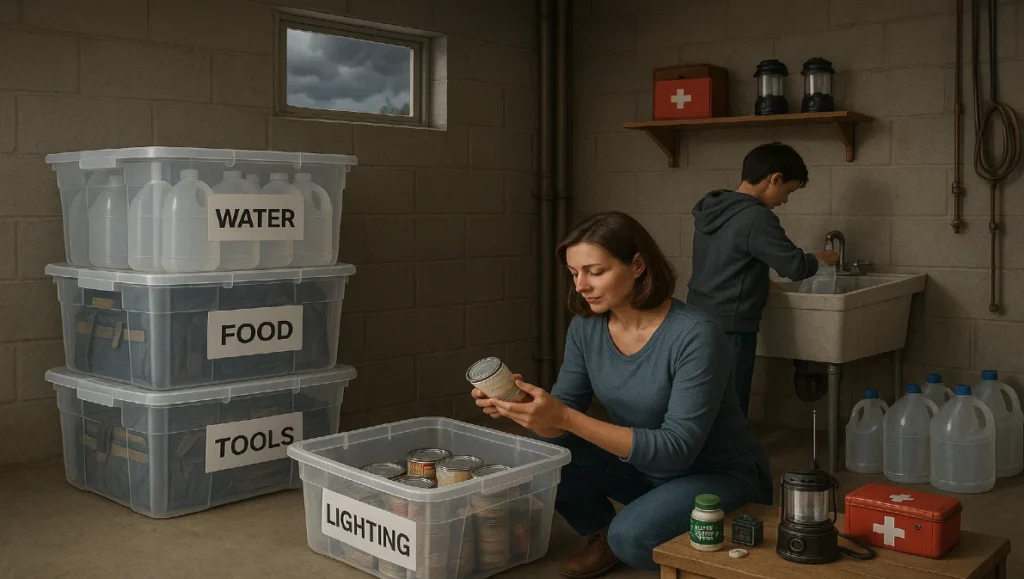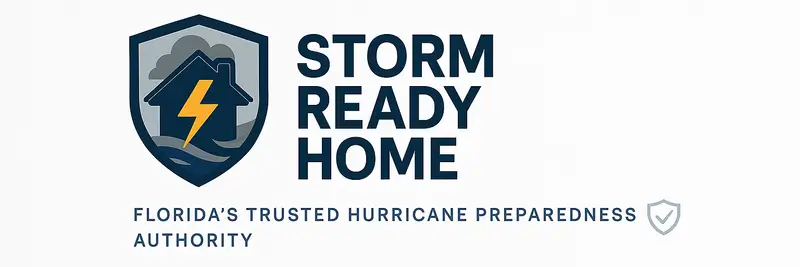
When a hurricane is on the way, your level of preparation can determine how well your family stays safe and how quickly your home recovers. Unfortunately, many people make critical mistakes before a storm even hits. These errors can lead to unnecessary damage, danger, and stress. This guide highlights the most common hurricane prep mistakes and gives you simple, clear ways to avoid them.
Why Hurricane Prep Mistakes Are So Common
Many people wait too long to prepare for a hurricane. Some believe the storm will change course. Others assume their area will not be hit hard, or they simply get overwhelmed and freeze. Busy schedules, lack of knowledge, and misplaced confidence all play a role. Even experienced homeowners make critical mistakes by relying on outdated plans or untested supplies. These small oversights can quickly become major problems when a real storm is on the way.
A Smarter Way to Get Storm-Ready
You do not need to be perfect to prepare well. What you need is a clear plan, reliable information, and the willingness to act early. Storm readiness does not come from last-minute panic shopping. It comes from building a simple, repeatable process you can trust. This includes testing your gear, storing supplies correctly, and reviewing your emergency plan every season. When a storm approaches, you want to focus on safety, not second-guessing your decisions.
Mistake 1: Waiting Until the Last Minute
This is one of the most common and dangerous mistakes people make before a hurricane. When you wait until a storm is only a few days away, shelves are empty, gas stations are crowded, and critical supplies are already gone. You may not have time to evacuate safely, prepare your home properly, or help others who rely on you.
What to do instead: Start your preparations early in the season. Create a checklist of supplies to maintain year-round. Schedule a monthly check to review your emergency kit, batteries, and backup power sources. If a storm is even mentioned in the forecast, take it seriously and act early. The earlier you prepare, the more choices and control you will have.
Mistake 2: Ignoring Evacuation Orders
Some people choose to stay behind when an evacuation order is issued, thinking they can ride out the storm or protect their property. This decision can put you and your family in serious danger. Flooding, flying debris, and power outages can make rescue impossible. Emergency services may not be able to reach you in time if conditions become life-threatening.
What to do instead: Always listen to local authorities. If you are told to evacuate, leave as soon as possible. Know your evacuation zone and plan your route in advance. Prepare a go-bag with essentials like medication, ID, snacks, and a phone charger. Let someone outside the storm zone know your destination and check in once you arrive.
Mistake 3: Failing to Test Emergency Gear
It is easy to assume your emergency gear will work when you need it, but batteries die, fuel goes bad, and devices wear out over time. Many people only discover a flashlight or generator is broken after the power is already out. This mistake can leave you without light, communication, or critical medical devices during the worst part of the storm.
What to do instead: Test all emergency gear at the start of hurricane season and again monthly if storms are active. This includes flashlights, radios, solar lanterns, portable battery packs, and backup power systems. Replace batteries, refill fuel, and run a quick function check. Store instruction manuals in your emergency bin in case you need to troubleshoot quickly.
Mistake 4: Storing Supplies Improperly

Having emergency supplies is not enough if they are damaged, expired, or hard to reach when you need them. Items stored in cardboard boxes can become soggy or moldy. Food left in hot garages can spoil. Flashlights buried in clutter may be forgotten or inaccessible in the dark.
What to do instead: Use sturdy, waterproof bins to organize your emergency supplies. Label each bin clearly and store them in a dry, cool location. Group items by category, such as food, first aid, tools, and lighting. Check expiration dates on food and medications regularly, and rotate items as needed. Make sure everyone in the household knows where the bins are stored and how to access them quickly.
Mistake 5: Underestimating Water Needs
Water is one of the most critical resources during and after a hurricane. Yet many people store far less than they actually need. Without clean water, it becomes difficult to drink safely, cook, wash, and flush toilets. Water systems may be down for days or longer after a major storm.
What to do instead: Store at least one gallon of water per person per day for a minimum of three days, though a seven-day supply is safer. Include extra water for pets, cooking, and hygiene. Use clean, sealed containers or commercial bottled water. As a backup, include water purification tablets and a gravity-fed filter in your emergency kit.
Mistake 6: Forgetting Backup Power or Batteries
When the power goes out, many of the devices we rely on stop working. Phones go dead, lights go dark, and medical equipment may shut down. If you do not have a backup power plan, you may find yourself without essential communication or lighting when it matters most.
What to do instead: Keep a variety of backup power sources ready to use. These can include portable battery banks, rechargeable lanterns, hand-crank radios, and solar-powered generators. Test each device regularly and keep charging cables in your emergency bin. Avoid relying on one power source alone. Redundancy is key in emergencies.
Mistake 7: Not Securing Outdoor Items
Even small objects left outside can become dangerous in hurricane-force winds. Patio furniture, potted plants, toys, and garden tools can turn into flying debris that causes injury or property damage. Unsecured items can also damage your own home, windows, or vehicles.
What to do instead: Walk around your property before the storm arrives and secure anything that could be lifted or blown away. Bring lightweight items indoors. Tie down or store heavier objects in a garage or shed. Trim weak tree branches and secure trash cans, grills, and decorations. A quick inspection can prevent serious damage later.
Mistake 8: Lack of Communication Plan
When cell towers go down or power is lost, staying in touch with loved ones becomes difficult. Many families have no clear way to communicate if they are separated during a storm. This can lead to confusion, panic, and wasted time when every second counts.
What to do instead: Create a simple communication plan before hurricane season begins. Designate an out-of-town contact who can relay messages for your family. Write down key phone numbers and store them with your emergency kit. Consider purchasing walkie-talkies or battery-powered radios for local use. Make sure every household member knows the plan and practices it at least once a year.
Mistake 9: Assuming Flood Insurance Covers Everything
Many homeowners believe their standard insurance policy covers flood damage, but that is rarely the case. Without separate flood insurance, you may be left paying out of pocket for serious repairs. Even renters and people outside high-risk zones can be affected by rising water.
What to do instead: Review your insurance policy carefully and speak with your provider about flood coverage. Consider enrolling in the National Flood Insurance Program (NFIP) if you are eligible. Keep digital and physical copies of your policy documents in your emergency file. Understanding your coverage before the storm can save you thousands in recovery costs.
Mistake 10: Not Practicing Your Emergency Plan
Many families create a hurricane plan but never test it. In a real emergency, panic can make even the best plans hard to follow. Without practice, it is easy to forget important steps or miss critical items when time is short.
What to do instead: Schedule a practice drill with your family at least once a year, ideally at the start of hurricane season. Review evacuation routes, go-bag locations, and how to shut off utilities. Make it a learning experience for kids and an opportunity to identify gaps. When everyone knows their role and the steps are familiar, response time improves and stress decreases.
Free Download: Storm-Ready Home Checklist
Preparation is easier when you have a checklist to follow. To help you stay organized, we have created a free printable checklist that covers all the essentials you need before, during, and after a storm. This checklist includes supplies, safety steps, gear reminders, and family planning tips.
Download your copy now and keep it with your emergency kit:
Get the Storm-Ready Home Checklist
Recommended Gear to Fix These Mistakes
Having the right gear on hand can make all the difference during a hurricane. Whether you are dealing with a power outage, flood risk, or evacuation, quality tools help you respond safely and confidently. Below are a few essentials to strengthen your emergency prep and avoid the mistakes listed above.
| Category | Item | Purpose |
|---|---|---|
| Power Backup | Solar Generator or Battery Bank | Keep phones, radios, and lights powered during outages |
| Lighting | Rechargeable LED Lanterns | Provide safe lighting without fire risk |
| Water | Gravity-Fed Water Filter | Ensure access to clean drinking water if supply is disrupted |
| Storage | Waterproof Bins and Dry Bags | Protect supplies from moisture and flooding |
| Communication | Battery-Powered NOAA Weather Radio | Stay informed during outages or when phones fail |
Visit our full guide for tested, reliable equipment:
Explore Emergency Preparedness Gear
FAQs About Hurricane Prep Mistakes
What is the most common mistake people make before a hurricane?
The most common mistake is waiting too long to prepare. This leads to empty store shelves, limited gas, and missed opportunities to evacuate safely.
How much water should I store for a hurricane?
You should store at least one gallon of water per person per day for a minimum of three days. A seven-day supply is ideal, especially if you have pets or medical needs.
Do I need flood insurance if I do not live near water?
Yes. Flooding can occur anywhere, especially during heavy storms. Standard homeowners insurance typically does not cover flood damage, so separate coverage is often needed.
How often should I test my emergency gear?
Test all critical gear at the start of hurricane season and check it monthly if storms are active. This includes flashlights, radios, generators, and power banks.
What should I include in my evacuation plan?
Your plan should include multiple routes, shelter options, a go-bag, a communication method, and contact information for someone outside the affected area.
Can I use candles during a power outage?
It is safer to use LED lanterns or battery-powered lights. Open flames increase the risk of fire, especially if windows are open or if you need to leave quickly.
Final Thoughts on Hurricane Prep Mistakes
Preparing for a hurricane is not about fear, it is about readiness. The most common mistakes happen when people underestimate risk, rely on outdated plans, or delay action. But with the right mindset, tools, and information, you can take control before the storm ever arrives.
Now is the time to update your plan, review your gear, and make sure your family knows exactly what to do. Avoiding these mistakes is simple when you start early and follow a proven plan.
Next steps:
- Download the free Storm-Ready Home Checklist
This printable guide is designed to help you avoid the most common hurricane prep mistakes and check every critical box before the next storm hits.
- Browse our recommended emergency gear
- Share this article with friends or family who may also be at risk
For official guidance and evacuation zones, visit Ready.gov and NOAA’s Hurricane Center.
Being prepared is not just smart, it is life-saving. Take action today and stay one step ahead of the storm.
